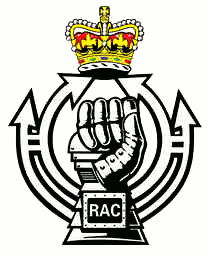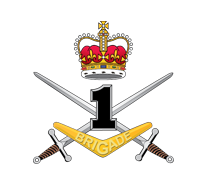
Plan Beersheba was a significant restructure of the Australian Army, announced in 2011. [1] The process of implementing the organisational changes began in 2014, and was completed in 2017. [2] [3]

Plan Beersheba was a significant restructure of the Australian Army, announced in 2011. [1] The process of implementing the organisational changes began in 2014, and was completed in 2017. [2] [3]
Under Plan Beersheba, the Army's three regular force combat brigades (the 1st, 3rd and 7th Brigades) were restructured into multi-role formations with a similar structure. [1] Before this time the brigades were structured as mechanised, light infantry and motorised infantry formations respectively.
Following the reorganisation, each of the multi-role brigades comprises: [2]
The three brigades rotate through a 36-month-long readiness cycle, comprising three 12-month phases. These comprise a 'reset' phase during which the brigade's soldiers conduct individual training, a 'readying' phase in which the brigade's units will prepare for combat operations, and a 'ready' phase in which the brigade is available to deploy. [5]
The 2nd Battalion, Royal Australian Regiment specialises in amphibious warfare. [5]
The three combat brigades are supported by the specialist 6th, 16th and 17th Brigades. [6]

Australian Army Reserve units were significantly restructured. As part of the changes, the Army stated that the reserves' role will become "to deliver specified capability and support and sustain Australian Defence Force (ADF) preparedness and operations". [7]
The six reserve brigades in the Army's 2nd Division have also been assigned a new role. Two army reserve brigades have been paired with each of the regular brigades. [7] The 4th and 9th Brigades have partnered with the 1st Brigade, the 5th and 8th Brigades with the 7th Brigade, and the 11th and 13th Brigades with the 3rd Brigade. [8] The pairs of brigades are expected to be able to provide a battalion-sized force upon mobilisation during the regular brigade's 12 month 'ready' phase. [7]
The structure of the reserve brigades has also been changed. The reserve artillery regiments have been re-equipped with mortars, the reserve Royal Australian Armoured Corps units converted from light cavalry to producing crews for Bushmaster Protected Mobility Vehicles, and a brigade operational supply company was established within each of the combat services support battalions. [7]

The Royal Armoured Corps is the component of the British Army, that together with the Household Cavalry provides its armour capability, with vehicles such as the Challenger 2 Tank and the Scimitar Reconnaissance Vehicle. It includes most of the Army's armoured regiments, both the Royal Tank Regiment and those converted from old horse cavalry regiments. Today it comprises twelve regiments, eight regular and four reserve. Although the Household Cavalry Regiment provide an armoured regiment, they are not part of the RAC.
The Infantry of the British Army comprises 49 infantry battalions, from 19 regiments. Of these, 33 battalions are part of the Regular army and the remaining 16 a part of the Army Reserve. The British Army's Infantry takes on a variety of roles, including armoured, mechanised, air assault and light.

A brigade is a major tactical military formation that typically comprises three to six battalions plus supporting elements. It is roughly equivalent to an enlarged or reinforced regiment. Two or more brigades may constitute a division.

The Australian Army Reserve is a collective name given to the reserve units of the Australian Army. Since the Federation of Australia in 1901, the reserve military force has been known by many names, including the Citizens Forces, the Citizen Military Forces, the Militia and, unofficially, the Australian Military Forces. In 1980, however, the current name—Australian Army Reserve—was officially adopted, and it now consists of a number of components based around the level of commitment and training obligation that its members are required to meet.

The Royal Yeomanry (RY) is the senior reserve light cavalry regiment of the British Army. Equipped with Supacat Jackal variants, their role is to conduct mounted and dismounted formation reconnaissance. The Regimental Headquarters is located in Leicester, with squadrons in Fulham, Nottingham, Dudley, Croydon, Telford, and Leicester. The regiment is part of the Royal Armoured Corps and is paired with and supports the 1st The Queen's Dragoon Guards (QDG). QDG and RY together form the light cavalry reconnaissance component of 7th Infantry Brigade, serving alongside six infantry battalions. The Royal Yeomanry is the only British Army Reserve unit to have been awarded a battle honour since the Second World War.
The Royal Australian Regiment (RAR) is the parent administrative regiment for regular infantry battalions of the Australian Army and is the senior infantry regiment of the Royal Australian Infantry Corps. It was originally formed in 1948 as a three battalion regiment; however, since then its size has fluctuated as battalions have been raised, amalgamated or disbanded in accordance with the Australian government's strategic requirements. Currently, the regiment consists of seven battalions and has fulfilled various roles including those of light, parachute, motorised and mechanised infantry. Throughout its existence, units of the Royal Australian Regiment have deployed on operations in Japan, Korea, Malaya, Borneo, Vietnam, Somalia, Rwanda, Cambodia, East Timor, the Solomon Islands, Iraq and Afghanistan.

The Land Component is the land branch of the Belgian Armed Forces. The King of the Belgians is the commander in chief. The current chief of staff of the Land Component is Major-General Pierre Gérard.

The Royal Australian Armoured Corps (RAAC) is a corps of the Australian Army which provides the Australian Defence Force's armour capability. Armour combines firepower, mobility, protection and networked situational awareness to generate shock action and overmatch in close combat. Armour is an essential element of the combined arms approach that is employed by the Australian Army.

1st Armoured Regiment is an armoured regiment of the Australian Army and is the senior regiment of the Royal Australian Armoured Corps. Formed as a tank unit in the new Australian Regular Army on 7 July 1949, the regiment subsequently saw service during the Vietnam War operating Centurion tanks. Currently the unit is based in Edinburgh, South Australia as part of the 9th Brigade. As part of the Plan Beersheba reorganisation, the unit has become one of three Armoured Cavalry Regiments (ACRs) assigned to the Army's multirole combat brigades in Brisbane, Darwin and Townsville. Each ACR is equipped with M1A1 tanks and ASLAV light armoured vehicles.

The 2nd/14th Light Horse Regiment is a regiment of the Australian Army and forms part of the Royal Australian Armoured Corps. The regiment is an Australian Light Horse unit, and has been widely romanticised and popularised in literature and poetry throughout the 20th Century. The unit sentimentally traces its lineage to 1860 and is the oldest Australian Regular Army unit through antecedent units the 2nd Moreton Light Horse (QMI) and the 14th West Moreton Light Horse (QMI). The regiment is assigned to 7th Brigade based in Brisbane and is equipped with the M1A1 Abrams tank and the ASLAV reconnaissance vehicle.

1st Brigade is a combined arms formation of the Australian Army. Formed in 1903 as a militia formation based in New South Wales, it was reconstituted as part of the Australian Imperial Force in 1914 for service during World War I, the brigade fought at Gallipoli and on the Western Front before being disbanded in mid-1919. In 1921, the 1st Brigade was re-raised as a unit of Australia's part-time military forces, based in New South Wales. During World War II the brigade undertook defensive duties before being disbanded. In 1948, it was re-raised as an integral part of the Australian Regular Army. Currently the brigade is based at Robertson Barracks in Darwin and at RAAF Base Edinburgh near Adelaide, South Australia. It is the first of the Australian Army brigades to be re-organised as a combat brigade under Plan Beersheba.

The 3rd Brigade is a combined arms brigade of the Australian Army, principally made up of the 1st and 3rd Battalions of the Royal Australian Regiment. Initially raised in 1903 as part of the post-Federation Australian Army, it was removed from the order of battle in 1906 following the restructure of the field force. It was re-formed in 1914 for service during World War I, taking part in the fighting at Gallipoli and on the Western Front in Europe. During World War II the brigade was used in a defensive role before it was disbanded in 1944. It was re-raised in 1967 for service during the Vietnam War and later went on to provide the nucleus of the deployment to East Timor during the Australian-led intervention in 1999. The brigade is currently based at Lavarack Barracks in Townsville, Queensland.

The 20th Armoured Brigade Combat Team, previously the 20th Armoured Infantry Brigade, is an armoured infantry brigade formation of the British Army, currently headquartered at Wing Barracks, Bulford, Wiltshire, as part of the 3rd Division.

The 8th/9th Battalion, Royal Australian Regiment is a motorised infantry battalion of the Australian Army. It was originally formed in 1973 by linking together both the 8th and 9th Battalions of the Royal Australian Regiment. Over the next twenty-four years the battalion would remain on the Australian Order of Battle based at Enoggera Barracks in Brisbane, Queensland, until it was disbanded in 1997 amid a number of Defence-wide cutbacks introduced by the Howard government. In 2006 it was announced that the battalion would be re-raised as part of a plan to expand the size of the Army and since then it established itself as a fully deployable motorised infantry battalion as part of 7th Brigade.
Army 2020 Refine was the name given to the restructuring of the British Army, in light of the Strategic Defence and Security Review 2015.
The 10th Light Horse Regiment is a "mounted infantry" regiment of the Australian Army Reserve, raised in Western Australia (WA).
Army 2020, was the name given to the restructuring of the British Army, in light of the 2010 Strategic Defence and Security Review.

The structure of the British Army is being reorganised to the Future Soldier structure. The Army is commanded by the Chief of the General Staff (CGS), with Army Headquarters which is located in Andover, Hampshire. Subordinate to that post, there is a Commander Field Army, and a personnel and UK operations command, Home Command.
Defence in a Competitive Age is a Ministry of Defence command paper which was released on 22 March 2021. It provided details on changes to the armed forces to meet the requirements of the Integrated Review which was published before it on 16 March 2021.
Future Soldier is a reform of the British Army resulting from the Integrated Review of Security, Defence, Development and Foreign Policy published in March 2021. The aim of the reform is to create a more lethal, agile and expeditionary force, able to fight and win wars and to operate in the grey-zone between peace and war. Future Soldier was published on 25 November 2021 and deals with the organizational changes of the British Army, with changes to personnel and equipment were set out in the Defence in a Competitive Age paper published on 22 March 2021.